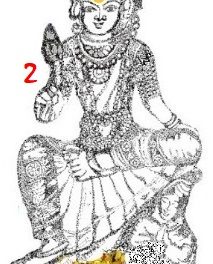கோடி வெங்கடரமணசாமி ஆலயம்
சாந்திப்பிரியா

இன்றுள்ள பெங்களுர் மானிலம் எழுந்த வரலாறே சுவையானது. வீரபல்லா என்ற சோழ மன்னன் கி.பி 1120 ஆம் ஆண்டு காட்டில் வேட்டையாசச் சென்ற பொழுது வழி தவறி விட அன்று இரவு ஒரு மூதாட்டி அவருக்கு தங்குவதற்கு இடமும் உணவுடன் வேக வைத்த பீன்ஸ் கறியும் தந்து உபசரிக்க, அவள் நினைவாக அந்த மன்னன் இன்றைய பெங்களுர் உள்ள இடத்தை உருவாக்கி அதற்குப் பெயர் பெங்களூரு (வேக வைத்த பீன்ஸ்) என பெயரிட்டான். அந்த இடத்தைத்தான் 1537 ஆம் ஆண்டில் கெம்ப கௌடா என்ற மன்னன் சீரமைத்து மூன்று மாவட்டங்களைக் கொண்ட நகராக அமைத்து அரண் அமைத்தார். காலப்போக்கில் அந்த நகரம் பல மன்னர்கள் கை மாறி மைசூர் அரசர்களுடைய வசம் ஆயிற்று. அப்படிப்பட்ட நிலையில் திப்பு சுல்தான் பெங்களுர் வந்து வாசம் செய்தார். அந்த முகலாய மன்னனின் ஆட்சியில் பெருமைப்பட்ட ஒரு ஆலயம்தான் பகவான் கோடி வெங்கடரமணசாமி ஆலயம்.
அற்புதமான திராவிடக் கலையழகில் சுமார் 300 ஆண்டுகளுக்கு முன்பாக கட்டப்பட்ட அந்த ஆலயத்தை சிக்கதேவராய உடையார் என்ற குறுநில மன்னர் நிறுவினார். அந்த ஆலயத்தின் பின்புறம் திப்பு சுல்தான் வந்து தங்கிய அரண்மனையும் குதிரை லாயமும் உள்ளன. 1790-92 ஆம் ஆண்டுகளில் நிகழ்ந்த மைசூர் யுத்தத்தில் பிரிடிஷ் படையினர் பரேட் கிரவுண்ட் என்ற இடத்தில் (பெங்களூரில் உள்ளது) இருந்து பெங்களூரில் பகவான் கோடி வெங்கடரமணசாமி ஆலயத்திற்குப் பக்கத்தில் உள்ள திப்பு அரண் மீது எய்த பீரங்கிக் குண்டு அந்த ஆலயத்தின் கருடக் கம்பத்தில் விழ திப்பு சுல்தான் அதில் இருந்துத் தப்பினர். அந்த குண்டினால் ஆலயப் பகுதி சேதமுற்றது. ஆலயத்தின் சில பகுதிகள் சேதம் அடைந்துள்ள நிலையை இன்றும் பார்க்கலாம். அந்த ஆலயத்தினால்தான் தன் உயிர் காப்பாற்றப்பட்டது என மனதில் எண்ணி மகிழ்ச்சி அடைந்த திப்பு சுல்தானும், ஹைதர் அலியும் அந்த ஆலயத்தை பெரிதும் மதித்து ஆதரவு தந்து வந்தார். அதனால் அந்த ஆலயம் இந்து முஸ்லிம் மத சகிப்புத் தன்மைக்கு எடுத்துக் காட்டாக விளங்கியது. சிக்க கிருஷ்ணதேவராயர் என்ற மன்னனுடைய மகனான காந்தீர்வ வாடியார் 1811 ஆம் ஆண்டு பகவான் கோடி வெங்கடரமணசாமி ஆலயத்திற்கு நன்றி விழா நடத்தி ஆலயத்தின் செலவிற்காக நான்கு கிராமங்களை தானமும் தந்து இருக்கின்றார். அந்த ஆலயத்திற்கு அருகில் திப்பு சுல்தான் அரண்மனையை தொட்டபடி பதினாறாம் நூற்றாண்டை சேர்ந்த பகவான் வினாயகர் ஆலயமும் உள்ளது.
ஆலயத்தின் உள்ளே நுழைந்ததும் தென்படுவது அற்புதமான பகவான் கோடி வெங்கட்ரமணஸ்வாமி மற்றும் பகவான் திருப்பதி ஏழுமலையான் – சன்னதி. கர்பக்கிரகம் இரண்டு அடுக்காக உள்ளது. அந்த சன்னதிக்கு தென் கிழக்குப் பகுதியில் கண்களை விட்டு அகல மறுக்கும் விதத்திலான பாறையில் செதுக்கப்பட்டுள்ள பகவான் ஆஞ்சனேயர் சன்னதி உள்ளது. சுமார் நான்கு அடி உயரம், மூன்று அடி அகலத்தில் ஒரு பாறையில் பகவான் ஆஞ்சனேயர் காட்சி அளிக்கின்றார். அவர் உண்மையிலேயே நிற்பது போன்ற தோற்றத்தை அந்த சிற்பம் தருகின்றது. பகவான் ஆஞ்சனேயர் சன்னதிக்கு எதிரில் உள்ள 30-40 அடி நீள மண்டபத்தில் நவக்கிரக நாயகர்களின் சிலைகள் சுமார் 3 அடி உயரத்தில் வெண்ணிர பாறைக் கல்லில் வடிவமைக்கப்பட்டு தூணில் வரிசையாக வைக்கப்பட்டு உள்ளன. அந்த தூண்களின் மேற் கூறையில் இராமாயணக் காட்சிகள் தத்ரூபமாய் சிலை வடிவில் செய்யப்பட்டு வைக்கப்பட்டு உள்ளன. பகவான் கோடி வெங்கட்ரமணஸ்வாமி சன்னதியின் வடமேற்குப் பகுதியில் உள்ளது மகாலஷ்மி தேவி சன்னதி. அந்த சன்னதியின் எதிரில் உள்ள மண்டபத்து தூண்களிலும் பல கடவுள் சிலைகள் வடிவமைக்கப்பட்டு உள்ளன. மேற் கூறையில் கிருஷ்ண பகவானின் லீலைகள், சப்த ரிஷிகள், சப்த கன்னிகைகள், பகவான் பிரும்மா, பகவான் விஷ்ணு, பகவான் மகேஷ்வர் போன்றவர்களின் சிலைகள் வெண்ணிர கல்லில் வடிவமைக்கப்பட்டு உள்ளது இன்னும் அற்புதம். ஆலயத்தின் நுழை வாயிலில் வானளாவிய கொடி மரம். ஆலயத்தில் நுழைந்தால் நாம் எதோ பழைய கால ஆலயத்தில் நுழைவது போன்ற உணர்வு ஏற்பட்டாலும் கண்களை விட்டு அகல மறுப்பது பகவான் அனுமார் சன்னதிதான் என்பது மறுக்க முடியாத உண்மை.
Kote Venkataramanasamy Temple
Santhipriya

How Bangalore city was established has an interesting story. In 1120 AD, when one of the Chola kings namely Veerapalla went for hunting in the jungle he lost way and he took refuge in the house of an old woman who offered him rice with boiled bean curry. On return back to his palace, the King created a city and named it as Bengaluru meaning boiled beans in local language in honor of that lady. This city was subsequently rebuilt in the year 1537 by another King called Kempa Gowda who fortified it into a city of three districts. Over the periods, the city came under the control of many kings and finally under the ruler of King of Mysore. During one such period, Emperor Tippu Sultan came and settled in Bangalore under whose regime Lord Kote Venkataramanasamy Temple got glorified.
The temple has been reportedly built before 300 years plus in the magnificent Dravidian style of art by a mini ruler called Chikkadevaraya Udayar. The Palace of Tippu Sultan who came and stayed here and the horse shed were behind Lord Kote Venkataramanasamy Temple. During the Mysore War of 1790-92, the bullet fired from cannon by the British troops from the Parade Ground (located in Bangalore) aiming at the Palace of Tippu Sultan hit the flag pole of this temple, damaging the temple area and thus Tippu sultan escaped. The damages caused by the bullets fired are visible even today. Both Tippu Sultan and Haider Ali, felt relieved that their lives had been saved by the temple and hence patronized it. So the temple remained as an example of Hindu-Muslim unity. In the year 1811, the son of King Chikka Krishnadevaraaya, donated four villages for the temple during its annual day function. Adjacent to the Palace of Tippu sultan has been a temple for Lord Ganesha which belonged to the 16th century.
Upon entering the temple, one can see the sanctum of magnificent Lord Kote Venkataramanasamy and Lord Tirupathi Ezhumalayan which is in two tires. To the south-east of the sanctum sanctorum is the shrine of Lord Anjaneyar, in which the sculpted out image of Lord Hanuman is seen on a rock stone as if he is standing there live, the beauty of which refuses to leave the eyes. The statue of Lord Anjaneyar is four feet high and three feet wide. In the 30-40 feet long hall in front of the shrine of Lord Anjaneyar, the images of the Navagraha have been carved in white stone measuring about 3 feet high and lined with pillars. On top of the pillars, the scenes from Ramayana scenes are seen. The sanctum of Goddess Mahalakshmi is located in the northwestern side of the sanctum of Lord Venkataramanasamy. Many idols of divines carved on the pillars of the hall in front of the shrine are also seen. The leelas (acts) of Lord Krishna, Saptha Rishis, and Saptha virgin maidens, Lord Brahma, Lord Vishnu and Lord Maheshwar are carved in white stone. Sky high Flag pole is seen in front of the temple. It is an undeniable fact that the statue of Lord Anjaneya on the rock is the star attraction in this temple.






